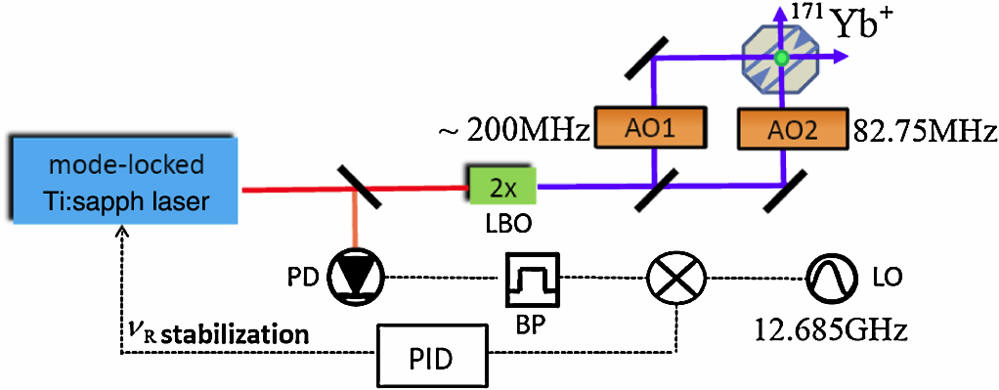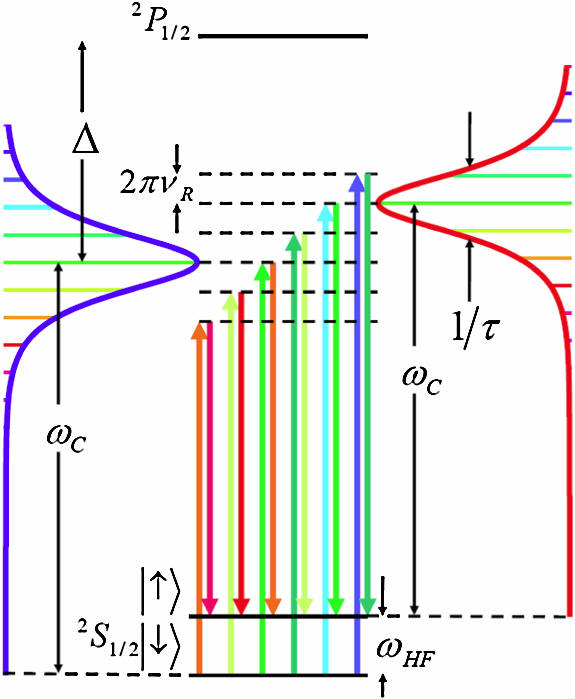
Del Mar Photonics - Newsletter Fall 2010 - Newsletter Winter 2010
Femtosecond lasers and atomic qubits (case study)
We require the femosecond laser to prepare our trapped ions into a motional
ground state by generating an optical frequency comb to drive specific ramen
transitions. (Phys. Rev. Lett 104, 140501)
Wavelength required is 374.1nm (9 THz detuned
from transition.) with a small amount of tunability (+/- 10nm.) Pulse duration
of 100fs.
Energy per pulse and output power arnt too much of a concern but ideally need to
be as high as possible.
Reference:
APS » Journals » Phys. Rev. Lett. » Volume 104 » Issue 14
Phys. Rev. Lett. 104, 140501 (2010)
Entanglement of Atomic Qubits Using an Optical Frequency Comb
(pdf)
D. Hayes*, D. N. Matsukevich, P. Maunz, D. Hucul, Q. Quraishi, S. Olmschenk, W.
Campbell, J. Mizrahi, C. Senko, and C. Monroe
Joint Quantum Institute, Department of Physics, University of Maryland and
National Institute of Standards and Technology, College Park, Maryland 20742 USA
Received 13 January 2010; published 5 April 2010
We demonstrate the use of an optical frequency comb to coherently control and
entangle atomic qubits. A train of off-resonant ultrafast laser pulses is used
to efficiently and coherently transfer population between electronic and
vibrational states of trapped atomic ions and implement an entangling quantum
logic gate with high fidelity. This technique can be extended to the high field
regime where operations can be performed faster than the trap frequency. This
general approach can be applied to more complex quantum systems, such as large
collections of interacting atoms or molecules.

Experimental set-up

The Stokes Raman process driven by frequency combs.
Del Mar Photonics lasers installed at NIST:
Trestles laser installation at NIST Quantum Communication Lab
One of the fundamentally important research areas involved in quantum
information science is quantum communications, which deals with the exchange of
information encoded in quantum states of matter or quantum bits (known as
qubits) between both nearby and distant quantum systems. NIST Quantum
Communication project performs core research on the creation, transmission,
processing and measurement of optical qubits the quantum states of photons, with
particular attention to application to future information technologies.
Most Resent Publications
Lijun Ma, S Nam, Hai Xu, B Baek, Tiejun Chang, O Slattery, A Mink and Xiao Tang,
" 1310 nm differential-phase-shift QKD system using superconducting
single-photon detectors ". New Journal of Physics, Vol. 11, April 2009.
Alan Mink, Joshua C Bienfang, Robert Carpenter, Lijun Ma, Barry Hershman,
Alessandro Restelli and Xiao Tang, " Programmable instrumentation and gigahertz
signaling for single-photon quantum communication systems ". New Journal of
Physics, Vol. 11, April 2009.
Lijun Ma, Alan Mink and Xiao Tang, "High Speed Quantum Key Distribution over
Optical Fiber Network System ", Journal of Research of the National Institute of
Standards and Technology, Vol. 114, Number 3, Page 149, May- June 2009.
A. Mink, S. Frankel, and R. Perlner, " Quantum Key Distribution (QKD) and
Commodity Security Protocols: Introduction and Integration ", International
Journal of network security and its applications, Vol. 1, No. 2, July 2009.
Lijun Ma, Oliver Slattery, Tiejun Chang and Xiao Tang, " Non-degenerated
sequential time-bin entanglement generation using periodically poled KTP
waveguide ", Optics Express, Vol. 17 Issue 18, pp.15799-15807 (2009).
Lijun Ma, Oliver Slattery and Xiao Tang, " Experimental study of high
sensitivity infrared spectrometer with waveguide-based up-conversion detector ",
Optics Express Vol. 17, Issue 16, pp. 1439514404 (2009).
Xiao Tang, Lijun Ma, Oliver Slattery, Single photon detection and spectral
measurement in near infrared region using up-conversion technology invited talk,
presented at LPHYS09, Barcelona, Spain, July 13-17, 2009.
Lijun Ma, Oliver Slattery, Tiejun Chang and Xiao Tang, Sequential time-bin
entanglement generation using periodically poled KTP waveguide, CLEO/ IQEC
(Optical Society of America, Washington, DC, 2009), JWA85.
Xiao Tang, Lijun Ma, Oliver Slattery, Single photon detection and spectral
measurement in near infrared region using up-conversion technology invited talk,
presented at LPHYS09, Barcelona, Spain, July 13-17, 2009.
Burm Baek, Lijun Ma, Alan Mink, Xiao Tang and Sae Woo Nam, " Detector
performance in long-distance quantum key distribution using superconducting
nanowire single-photon detectors ", Proc. SPIE, Vol. 7320, 73200D (2009).
Oliver Slattery, Alan Mink, and Xiao Tang, " Low noise up-conversion single
photon detector and its applications in quantum information systems ", Proc. of
SPIE Vol. 7465, 74650W, 2009.
Oliver Slattery, Lijun Ma and Xiao Tang, " Optimization of photon pair
generation in dual-element PPKTP waveguide ", Proc. of SPIE Vol. 7465, 74650K,
2009.
Oliver Slattery, Lijun Ma and Xiao Tang, High-Speed Coincidence Photon Pair
Generation by Dual-Element PPKTP Waveguide over GHz repetition rate, submitted
to Frontier in Optics 2009 (the 93rd annual meeting of Optical Society of
American, San Jose, October, 2009). WERB review approved.
Trestles CW Ti:Sapphire laser is used at NIST to trap nanoshells
Brooke Hester is a PhD student working in the Optical Tweezers Lab at the National Institute of Standards and Technology (NIST). In this video she tells about trapping polystyrene spheres and nanoshells using Trestles CW - continuum wave tunable Ti:Sapphire laser from Del Mar Photonics.
A nanoshell is composed of a spherical core of a particular compound surrounded by a shell of a few nanometers in thickness. One of the promising applications concerns the biological field. Research is being performed to create nanoshells with high absorptions at biologically useful wavelengths by altering the thickness of the shells. Particularly, the Near Infra Red region, which corresponds with low absorption by tissue, may be useful.
In the literature, special attention is given to gold nanoshell with a dielectric core (gold sulfide, silicon dioxide,...). Gold is a biocompatible compound, making it a useful material for medical applications. However the overall size of silica/gold nanoshells may make clearance of these particles a problem in use in the body. To be removed from the body via the kidneys (renal system), a particle's hydrodynamic diameter must be approximately less than 6nm. Long term in vivo toxicity studies must be undertaken to determine the toxicity of any nanoparticle.
Nanoshells are currently being investigated as:
• a treatment for cancer similar to chemotherapy but without the toxic
side-effects
• inexpensive, quick analysis of "samples as small as a single molecule" and
builds on Raman spectroscopy
Gold (Au) nanoshells exhibit tunable plasmonic resonance based on the ratio of the shell to core thickness. In addition the overall size of such a particle allows independent control of its scattering cross section.